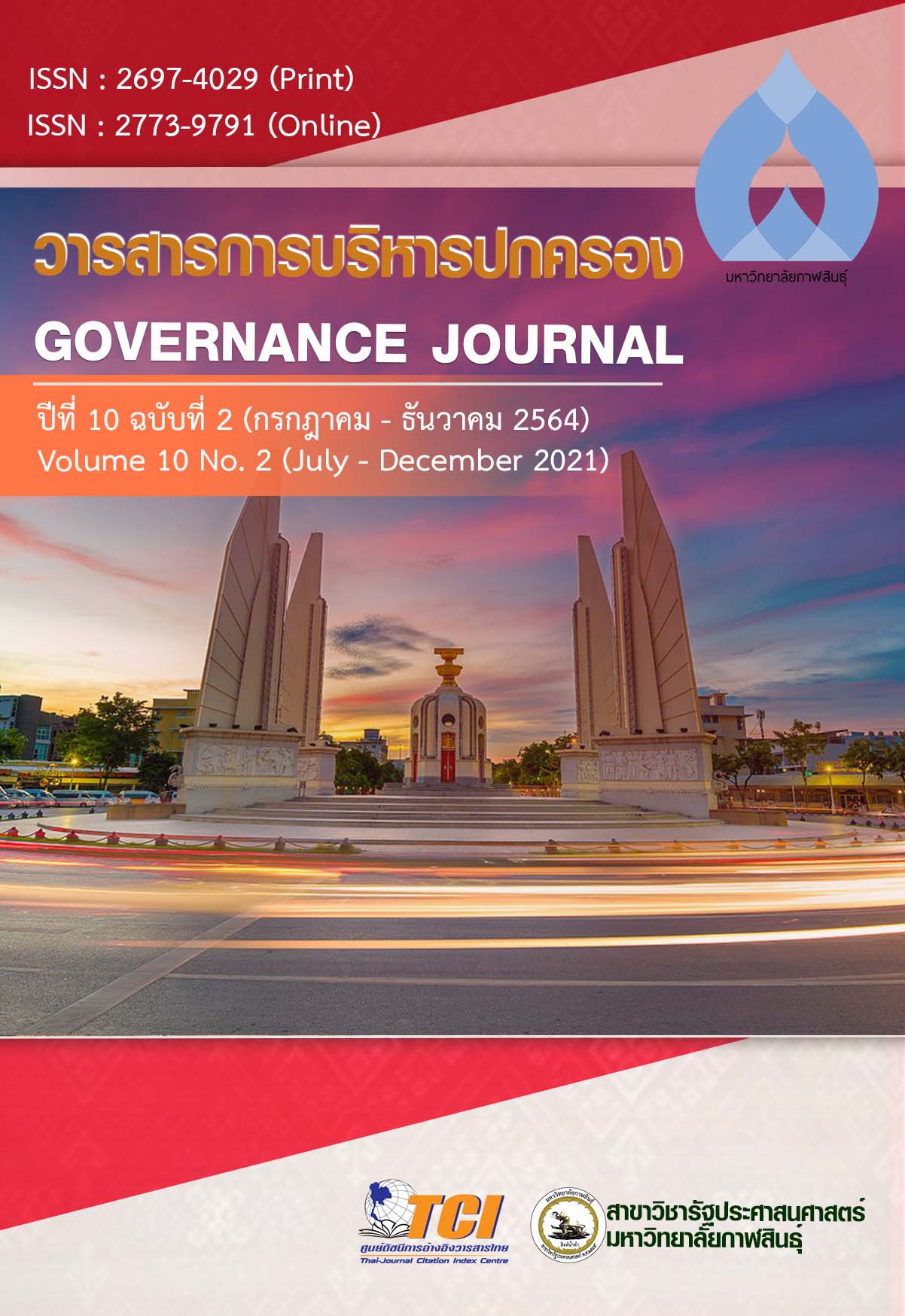กลไกความร่วมมือเชิงพื้นที่เพื่อแก้ไขปัญหาความยากจน จังหวัดกาฬสินธุ์
DOI:
https://doi.org/10.14456/gjl.2021.32คำสำคัญ:
คำสำคัญ : การแก้ไขปัญหาความยากจน,การนำนโยบายไปปฏิบัติ,กลไกเชิงพื้นที่บทคัดย่อ
กลไกความร่วมมือเชิงพื้นที่เพื่อแก้ไขปัญหาความยากจนจังหวัดกาฬสินธุ์ เป็นการศึกษาเพื่อวิเคราะห์ข้อมูลคนจนและหนุนเสริมกลไกพัฒนาเชิงพื้นที่เพื่อแก้ไขปัญหาความยากจนของจังหวัดกาฬสินธุ์ใช้ระเบียบวิธีเชิงคุณภาพ (Qualitative methods) ผู้ให้ข้อมูลที่สำคัญ (key informants) ได้แก่ ผู้ว่าราชการกาฬสินธุ์ ปลัดจังหวัด พัฒนาการจังหวัด ท้องถิ่นจังหวัด ประธานหอการค้า ประธานสภาอุตสาหกรรม นายอำเภอ ปลัด นายกเทศมนตรี นายกองค์การบริหารส่วนตำบล กำนัน ผู้ใหญ่บ้าน นักวิชาการ ตลอดจนคนจนกลุ่มเป้าหมาย จำนวน 24 คน เกณฑ์ที่จะใช้กำหนดจำนวนผู้ให้ข้อมูล คือ ความเข้มในการรู้ข้อมูล (Intensity) และความพอเพียงของข้อมูล (adequacy)สร้างข้อสรุปแบบอุปนัย (Induction) โดยการสร้างข้อสรุปทั่วไปที่มีความเชื่อมโยงจากการสังเกต เชิงประจักษ์ (Empirical Observation) และ ใช้การตีความ (Interpretative) เข้ามาวิเคราะห์ผลการศึกษา ร่วมกับโปรแกรมวิเคราะห์ข้อมูลเชิงคุณภาพ ATLAS.ti ผลการศึกษาพบว่า กลไกการสร้างความร่วมมือ ทั้งกับหน่วยงานราชการ และภาคีอื่นให้มาร่วมทำงาน การสร้างความร่วมมือกับหน่วยงานราชการและภาคีในการทำงานระดับพื้นที่ มหาวิทยาลัยกาฬสินธุ์ได้ดำเนินการ สร้างความร่วมมือใน 2 ลักษณะ คือ 1. การสร้างความร่วมมือแบบทางการ ผ่านคำสั่งทางปกครอง ในกรณีที่จังหวัดเป็นผู้ขับเคลื่อนนโยบาย และการทำหนังสือเชิญของหน่วยงานในระดับเดียวกันเพื่อขอความร่วมมือในการเป็นภาคีความร่วมมือ และ 2.การสร้างความร่วมมือแบบไม่เป็นทางการ ผ่านเครือข่ายที่เกิดจากการสร้างวงเสวนา การประชุมในสภากาแฟ และชุมนุมนักปฏิบัติ (Community of Practice) เกิดเป็นความสัมพันธ์ส่วนตัวและนำมาซึ่งการประสานงานที่ไม่เป็นทางการระหว่างหน่วยงาน ผลการศึกษาแสดงให้เห็นว่ากลไกในการขับเคลื่อนความร่วมมือเพื่อแก้ไขปัญหาความยากจน ซึ่งเป็นปัญหาที่ซับซ้อนจำเป็นต้องใช้ความร่วมมือในทั้ง 2 ลักษณะ คือ ความร่วมมือที่เป็นทางการและไม่เป็นทางการเพื่อให้นโยบายสามารถนำไปปฏิบัติได้บรรลุวัตถุประสงค์ทางนโยบาย
Downloads
เอกสารอ้างอิง
เอกสารอ้างอิง
ภาษาไทย
สำนักงานคณะกรรมการพัฒนาการเศรษฐกิจและสังคมแห่งชาติ. (2561). สำนักงานคณะกรรมการพัฒนาการ
เศรษฐกิจและสังคมแห่งชาติ. เรียกใช้เมื่อ 24 พฤษภาคม 2563 จาก สำนักงานคณะกรรมการพัฒนาการเศรษฐกิจและสังคมแห่งชาติ: https://www.nesdc.go.th/ewt_w3c/more_news.php?cid=383&filename=
สำนักงานจังหวัดกาฬสินธุ์. (2561). แผนปฏิบัติการ Kalasin Happiness Model คนกาฬสินธุ์ไม่ทิ้งใครไว้ข้างหลัง
พ.ศ.2561 – 2564.สำนักงานจังหวัดกาฬสินธุ์. (2561). แผนพัฒนาจังหวัดกาฬสินธุ์ 2561-2564 (ฉบับทบทวน 2562).
สำนักงานพัฒนาวิทยาศาสตร์และเทคโนโลยีแห่งชาติ. (3 พฤษภาคม 2563). สำนักงานพัฒนาวิทยาศาสตร์และ
เทคโนโลยีแห่งชาติ. เรียกใช้เมื่อ พฤษภาคม 2563 จาก สำนักงานพัฒนาวิทยาศาสตร์และเทคโนโลยีแห่งชาติ: https://www.tpmap.in.th/2562/46
ภาษาอังกฤษ
Agranoff, R., & McGuire, M. (2003). Inside the matrix:
Integrating the paradigms of intergovernmental
and network management. International Journal
of Public Administration, 26(12), 1401-1422.
Ansell, C., & Gash, A. (2008). Collaborative governance in
theory and practice. Journal of public administration research and theory, 18(4), 543-571.
Ellis, F. and N. Mdoe, (2003). ‘Rural Livelihoods and
Poverty Reduction in Tanzania’,World
Development, Vol.31, No.8, August
Hardy, C., Lawrence, T. B., & Grant, D. (2005). Discourse
and collaboration: The role of conversations and
collective identity. Academy of management
review, 30(1), 58-77.
Pestoff, V. & Brandsen, T. (2010). Public Governance and
the Third Sector: Opportunities for Co-production
and Innovation?. In The New Public Governance?:
Emerging Perspectives on the Theory and
Practice of Public Governance. Osborne, S. P.
(ed.). London: Routledge.
Stephen P. Osborne (2010) Delivering Public Services:
Time for a new theory?, Public Management Review, 12:1, 1-10, DOI: 10.1080/14719030903495232
Osborne, S. P., Radnor, Z., Kinder, T., & Vidal, I. (2015).
The SERVICE framework: A public service
dominant approach to sustainable public
services. British journal of management, 26(3),
-438.
Osborne, S. P. (2010a). Introduction: The (New) Public
Governance: A Suitable Case for Treatment ?. In
The New Public Governance ?: Emerging
Perspectives on the Theory and Practice of
Public Governance.
Stephen P. Osborne (ed.). London: Routledge. . (2010b).
Conclusion: Public Governance and Public
Services Delivery: A Research Agenda for the
Future. In The New Public Governance ?:
Emerging Perspectives on the Theory and
Practice of Public Governance.
Stephen P. Osborne (ed.). London: Routledge. Osborne,
S. P., Mclaughlin, K., & Chew, C. (2010).
Relationship Marketing, Relational Capital and
the Governance of Public Services Delivery. In
The New Public Governance ?: Emerging
Perspectives on the Theory and Practice of
Public Governance. Stephen P. Osborne (ed.);
London: Routledge.
Translated Thai References
Office of the National Economic and Social
Development Board ( 2018). Office of the
National Economic and Social Development
Board. Run on 24 May 2020 from the Office of the National Economic and Social Development Board. Retrieved from https://www.nesdc.go.th/ewt_w3c/more_news.php?cid=383&filename
Kalasin Provincial Office( 2018). Kalasin Happiness Model
Kalasin People's Plan Leaves No One Behind 2018
– 2021. Kalasin. Provincial Development Plan
-2021 (Revised 2019).
National Science and Technology Development Agency.
National Science and Technology Development
Agency. Run on May 2020 from The National
Science and Technology Development
Agency. Retrieved from https://www.tpmap.in.th/2562/46
ดาวน์โหลด
เผยแพร่แล้ว
รูปแบบการอ้างอิง
ฉบับ
ประเภทบทความ
สัญญาอนุญาต
ลิขสิทธิ์ (c) 2021 วารสารการบริหารปกครอง

อนุญาตภายใต้เงื่อนไข Creative Commons Attribution-NonCommercial-NoDerivatives 4.0 International License.








